We are witnesses to the huge leap content is making nowadays, and we need to adapt our content marketing strategies. We need to stand out in the crowded content space. But where should we start from?
Plato’s saying is one many writing talents and content gurus hold dear to, and it goes like this: “Those who tell the stories, rule the world”.
Content has always been a powerful weapon for whatever those who knew how to wield it were after. Kings knew its importance, historians did too, and now content marketers, big and small, mold it in infinite ways to obtain that successful and attractive mix to make them outstanding in the ever-changing marketing ecosystem.

Every Google update, be it Panda or Penguin, drew the digital marketing industry closer to the tipping point where content is now king. If links used to be the first and foremost factor in ranking higher and dictating the success of a brand, now content is.
Today content is more pregnant than ever. It is the one thing that is going to make the difference in a really hectic noisy market place.
Tools come in handy in this type of situations. BrandMentions can provide the information for your content to rank higher in Google, learn from your competitors’ tactics and success strategies, and reveal popular keywords. For moments when things get tougher, we’ve created a personal content assistant.
Our Keyword Tool gives access to keywords and articles written on the topic entered in the search, suggests you techniques in making your content perform better and assists you in delivering that top-notch piece of content. Following Content Assistant recommendations comes in handy for content creation because it shows you the evolution of your content (through the content performance score).
We made some research and here are some tactics to create high-ranking content:
- How to Identify and Craft Stellar Content (Case Study Release)
- How to Keep Up With the Content Marketing Industry Nowadays
- How Content Has Evolved In Time
1. How to Identify and Craft Stellar Content
Yes, content is eating the world and we all need to adapt and make changes and improvements in our marketing strategies so to hit that big leads we all crave for.
With the proper search engine optimization tools, you can deal with content the way you need, and turn the odds in your favor. BrandMentions and Keyword Tool come with a full set of features and tools meant to change the game once you start using them.
Content marketing doesn’t happen overnight, especially with its continuous reinvention and advancement of technology. To best illustrate how you can improve your content and make it outstanding among so many other pieces of content out there, we will use the formerly mentioned tools, namely BrandMentions and Keyword Tool.
After all this content revelation, three steps we need to follow:
1.1 Dig into Your Competitor’s Success Strategies
It’s time you stopped making content that nobody engages with. You need to learn two things:
- Who’s there to take lessons from?
- How are my brand and content performing?
1. Deploy a topic search that’s representative to your niche and see who’s out there doing the same thing as you. Using the right tool in digging your competitors’ success strategies is game changing.
After seeing who the competitors in the niche are, start analyzing each of them. See how many brand mentions they’ve got, the performance score, and social shares of their pieces of content, and try to figure out what strategies they use, and go outrun them, while still being authentic.
We compared two grand names in the computer industry and we tried to see how their brand and content is performing while being mentioned by other websites. We sought to see the number of mentions, type of webpages – either authoritative or low-quality page – performance score, and social shares. Plus, we wanted to see if mentions and their context were fitting the brands and were confirming their quality. The chosen brands were Apple and Microsoft.
BrandMentions shows that Apple holds the highest number of mentions. The top results are quite relevant, given the authority of the websites, namely iTunes, New York Times, CNET, or Huffington Post.
2. Keyword Tools can easily show you monthly search volume for your query, keyword suggestions filtered by relevancy, number of words, CPC and other topic groups.
After seeing Google’s top results for your targeted keyword, see how your content would rank and perform among all the content that’s already there and occupying those first spots in search engine results. It is a real benefit to see relevant content and help you create the best content out there.
Keyword tool comes in handy and proves to be the content assistant your content lacks. After analyzing top used keywords in the niche and entering them in your body of text, enter your article in the semantic content optimization sector and see how your content performs.
1.2 Feed Your Readers with Relevant and Consistent Stories
You need to pull yourself together and sort your content by engagement metrics so to bring all the bits that keep people around your brand the longest to the top.
As mentioned before, social media holds a great deal of the content available online. Therefore using BrandMentions, see how others perform on social media, and create, provide and feed your readers with relevant and consistent stories. An audience that was previously clearly outlined and given a clear purpose will answer to and engage with your content.
For the time being, BrandMentions offers you deep insight on social networks such as Twitter and Youtube, planning to extend its action area to other networks as well. The Keyword Tool doesn’t fall short and covers the same social networks as well, apart from the whole wide web.
1.3 Gain Insights on Your Competitors’ Content Performance
Needless to say this once again, metrics and analyses will do the job. Keyword Tool allows you to gain deep insight on your competitors’ ranking score, used keywords, number of words, and also to check their page and domain performance. Just in case you’ll want to see whom you’re against (the screenshots above are a perfect illustration of what we’re saying here).
Oh, and metrics, metrics, metrics everywhere. In order to make your content a hit, you’ll need to work your piece of content till it’s shinier than a diamond.
The keyword explorer, ranking analysis, and content assistant tools Keyword Tool are working together to accomplish just that. Improving your content marketing approach could not get any easier with the right tools.
And with a good pinch of creativity, things will surely work out. As content marketers, we know that creativity wins over the cost of production. And style as well.
Just look at TechCrunch’s story. TechCrunch is a leading technology media publication, dedicated to obsessively profiling startups, reviewing new Internet products, and breaking tech news. But all started from way less. Michael Arrington created a blog out of a hobby – sharing information about the companies that were making a difference in the world of web. Now it’s the leading online publisher of technology news in the world.
It’s the dream of any entrepreneur to get featured and displayed to the large amount of tech players following TechCrunch. The secret is this: cadence, style, and proper content management. You can find more here.
2. How to Keep Up With the Content Marketing Industry Nowadays
As if content available on the web was not enough, social networks have long started to record considerably higher rates in delivered content compared to that of the web.
2.1 Use Social Amplification Strategies to Outperform Your Content
We are witnessing a huge leap in technical usage and capabilities. People are increasingly using their phones for everything. Thus, it’s more likely that content should be created there than offline.
What’s more, social networks seem to have taken over every information sector and content-driven institution. Journalism, banking systems, personal histories, political campaigns, leisure industry, retail, and even government and security, all are filtered through social media first.
Interesting enough is that social media was not intended to become the shortest press release or primary marketing ad medium, yet many companies use it this way.
Facebook, LinkedIn, Twitter, Instagram, Snapchat, and so on, are very powerful in matters of both content and readers. As Jay Baer points out in the video above: “Content is fire. Social media is gasoline.” Social media marketing comes as the amplification player that complements content that it’s already there. It acts as a booster and as an awareness button.
And there’s proof. In-handy, for anybody. Let’s take this instance when you’re searching for brand mentions on the internet. For this experiment, we will use our mentions tool, BrandMentions.
With BrandMentions you can benefit from gaining deep insight not only on publications that mentioned you but also on the medium where that piece of content is posted on. And because numbers talk best, let’s see the search results.
After opting for a preferred language, location, and period of time, BrandMentions displayed a good bunch of mentions, all up to date and on the topic.
The number of mentions is way bigger, as shown in the right upper corner, and you can have full access to the entire set of mentions after a paid subscription. Although the total number of mentions can’t be accessed, this snippet is representative for the total sum. Either way, this is one instance where a social network overcomes the content available on the web.
Social media occupies a significant role in content generation across the globe, and brands need to count it in their marketing strategies, otherwise, they could easily perish.
Judging the latest numbers for social networks, content is king now more than ever. With Facebook scoring 1.71 billion users, Youtube hitting over 1 billion users, WhatsApp having a total of 1.2 billion users, and LinkedIn reporting 450 million users, it’s no wonder where all that social content comes from.
If not yet convinced, statistics show that the top 3 content marketing tactics are blogging (65%), social media (64%), and case studies (64%). It’s a competition all the way down!
2.2 Implement Various Types of Content to Fit People’s Need
Content comes in a variety of forms, all meant to entertain and satisfy as many of the human senses as possible. We are witnesses to the competition social networks of all kinds are in.
Youtube is a video-sharing website, Instagram, Pinterest and Flickr are photo-sharing services, Facebook is a social networking service that combines both text, video, and audio, while Soundcloud and Spotify are music, podcast, and video streaming services with millions of subscribers across the world.
Be it video, audio, or text, social networks are fighting to exceed users’ expectations and deliver their best content possible, just as Joe Coleman mentioned.
| Your content is a product unto itself and you have to find out where it fits into the broader ecosystem of people’s needs and wants. | |
| Joe Coleman | |
| CEO at Contently / @JoeDColeman | |
Interesting though it’s the way video climbed all the way up and is thought to be the future of online marketing. According to Cisco, starting with 2017, video will account for 69% of all consumer internet traffic.
Video-on-demand traffic alone will be trebled. Wisdom calls for small enterprises and businesses to include this medium in their marketing strategies, if not willing to fall behind trend and expectations.
One way or the other, video gains ground because it can offer information that is simple to digest, and can provide the entertainment and knowledge people need.
Yet, what goes around, comes around. Video is poised to soon take over the social media content, but one way or another, video will need sharing and promotion from social networks. Shares will raise awareness and make video successful. As Andy Crestodina says it:
| It’s not the best content that wins. It’s the best-promoted content that wins. | |
| Andy Crestodina | |
| Co-founder of Orbit Media / @crestodina | |
As a consequence, there is a dependency loop.
Both BrandMentions and Keyword Tool can crawl videos when entering queries in the search bar. Using the entered query, they browse the web and display results according to your previously selected filters. It is great for keyword research. For now, search engines can crawl videos with the help of video title, description, script and URL. Hopefully, in the rather nearer than farther future, search engines will be able to crawl videos by scanning the audio only.
If you need to get more out of your content, Keyword Tool is a fit aid in learning who are the competitors out there who ranked for the same topic or keyword, and see where their success comes from. You get insight into content performance, which tells you how relevant and optimized that content is for the analyzed keyword. Other important details such as usage of focus keywords, readability score, and number of words on the page are available for both web posts and videos.
2.3 Follow Amazon’s Social Strategy to Create a Community
Did you know that Amazon is actually more of a social network rather than a merchandise website? Here’s why.
Amazon is by far the no. 1 go-to website when you are looking for insight into the usability and features of a product, brand and so on. According to 2016 statistics, there are 7 million Amazon reviews. This is the place where millions of subscribers connect with each other, share impressions, and act as a community.
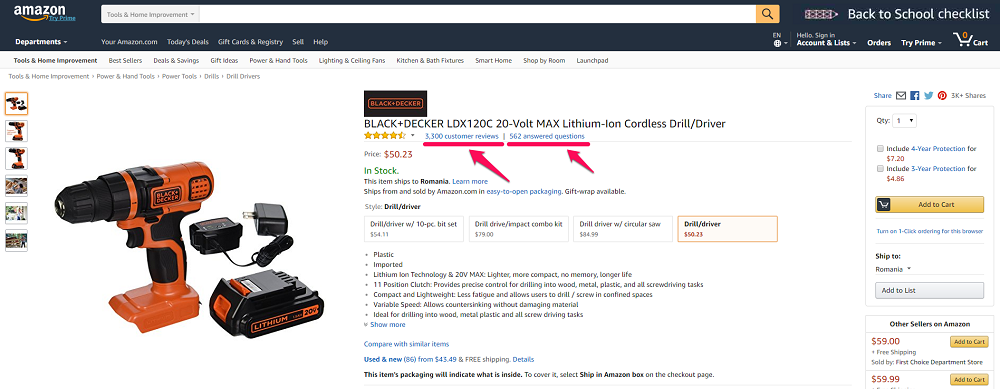

Reviews are not the sole content generator; so are product descriptions. Content is everywhere; just follow the length of a mouse scroll and you’ll see it for yourself. Plus, Amazon actually started as a bookstore, later diversifying and extending the business to other niches. Content, content, content everywhere.
3. How Content Has Evolved in Time
Content is part of that well-known paradigm meant to help web pages rank higher, have better conversion rates, and get the leads they’re after: inbound links, content, and UX interface.
The place content has occupied is not something new to marketers. Yet Andrey Lipattsev, a Search Quality Senior Strategist at Google, made it clear that content is one of the most important Google ranking factors.
Contrary to its privilege, content was just a player in the game and not the King Kong it is today, taking over the world.
3.1 Before and After the Algorithm Change
There was a time when companies had to take a break and ask themselves: What are we getting out of content? Is it working the way it should? Big questions in terms of what to write, what to track and of the final objective that came along with the new Google Panda update, in 2011. Why then? Because it impacted big content players the way it hadn’t done before.
Marketers in the content industry know the story of content giant Demand Media and its decline. The company was a leader in the market, created to revolutionize content production in various lifestyle industries such as art, design, health, fitness, and DIY. Everything changed once Google released its Panda algorithm in 2011, which was meant to track down low-quality but highly promoted content. That’s when Demand Media went down.
And this is when things started to swerve and they reconsidered their tactics and priorities. The mentality was the first thing to change. And content metrics were there to be used and help the new processes.
Joe Coleman, Contently CEO, says that after he witnessed the rise of the company in times of unfavorable odds, creating content marketing material just because you have to, won’t work.
| Too many people were approaching it purely as an art. Now, to succeed, you have to take that art and apply a much more scientific, data-driven framework to it. | |
| Joe Coleman | |
| CEO at Contently / @JoeDColeman | |
3.2 Use Tips That Make Content Win the Lottery
Content called for a massive facelift. In the years that have passed since 2011, multiple tips and tricks have surfaced on the web on how to make your content shine and and increase search rankings.
Among the vast array of suggestions for content optimization, there is a track record of 9 tips, old and new, that can help you create high-quality content and boost it to where it should be – on the top.
1. Set realistic expectations and wait.
- Patience is the root of all long-term success.
- Know yourself.
- Set realistic objectives. Do not haste for immediate outcomes.
- Yet track those set benchmarks, and do follow up.
2. Discover your audience and work towards them.
- Identify the audience that seeks the same thing as you, people you’d want to sell your product to and who would be drawn to your brand.
- Create content on topics they need.
- Make it top-notch.
3. Be consistent, create a plan you can really execute.
- Make a scenario you can actually keep track of and follow closely.
- Set your own post pace.
- Measure traffic.
- Collect email addresses, and email your subscribers, so to create a solid relationship and secure a loyalty loop.
| Email is almost always more valuable than social media. | |
| Joe Coleman | |
| CEO at Contently / @JoeDColeman | |
4. Be different.
- Make research and see what’s already there in your industry.
- In order to be a competitor, you need to bring something there’s not already there. Something different, something more.
- Be authentic.
- Find your voice and style and stick to it.
5. Have an audience.
- Learn how to retain people organically.
- There are a series of white-hat techniques to gain traffic. Write blog posts on Medium and LinkedIn, places where you already have a good set of followers.
- Employ ego bait tactics.
- Seek to get links and tweets from influencers in the industry, and shares from investors.
- Opt for syndications – pitch a piece of your content to notable publications.
6. Don’t go for quantity, but for quality.
- Quality content has and will always perform better than quantity content.
- Opt for usefulness.
- Create content that’s well-researched and well-crafted.
- Don’t build fame on pennies, but on diamonds.
7. Track yourself using metrics that matter.
Metrics, metrics, metrics everywhere. Metrics help you to constantly grow and measure development.
- Track unique visitors.
- Register engagement rate as its data is eye-opening and very important.
- Don’t follow just the clicks and impressions.
8. Build your site beautifully, yet make it usable.
- People are attracted to smart engaging design. Make it so! 56% of marketers claim personalized content drives higher engagement.
- Try to stand out, but stay true to yourself, though.
- Usefulness is ever more important than beauty, so optimize your site/blog/publication to its best.
- Turning your site into what readers are looking for shows that you take them and your business seriously.
- Avoid interstitials.
9. Experiment for the sake of the future.
- Don’t stagnate once you’ve accomplished one content objective. Go to the next one.
- See what your readers digest more and, if possible, try to go beyond your originally set milestone.
- Use A/B testing either for content type, design, post frequency, or contributors. It’s simple math: channels, content, and contributors.
- Don’t forget to stay qualitative.
One way or another, you want to stay safe and yet shine on with your content, so following these simple yet engaging tips on how to improve your content, will surely be to your benefit.
Using the outline above, we shall apply it to a more hands-on experiment on how you can master content in a world already full of it. All with the help of BrandMentions and Keyword Tool.
Conclusion
Seth Godin says that “content marketing is all the marketing that’s left” and to some extent, that’s true. In such times when content of all types and forms battles to be that yummy cherry on the top, it’s almost excrescent to deny it.
And truth be told, we love content. Good, smart content with a twist, content we can chew on and develop further. That’s why brands struggle to have as few content quality debts as possible. No doubt, content marketing is a full-time marathon.
Digital marketing started long ago to be the big brother of businesses’ success already. Yet content has slowly but steadily started to take ground from inside out and eventually take over the reins of the entire marketing game.
This is an age of information overload; new startups and global giants witness the continuous rise of content and fight to keep up with the trend. Content is eating the world and brands need to create content around them if they want to thrive.
Content grows faster in demand than we’d expect it to. The message is that it’s no longer just a matter of inspiration but one of tight calculus and data.
Content marketers started to create and rethink algorithms and metrics to help their content pop up in the business industry.
Yet social networks hold a great share in the rise of content. They have created such a surplus of content that they considerably surpass web posts and everything in between. And this is just the beginning.
Numbers never lie, some say, so here are some astonishing facts about content provided by social networks.
Every 60 seconds, 510,000 comments are posted, 293,000 statuses are updated, and 136,000 photos are uploaded on Facebook.
Twitter, the king of all instant posts, records on average around 6,000 tweets every second, which corresponds to over 350,000 tweets sent per minute, 500 million tweets per day, and around 200 billion tweets per year. For a live sneak peak, you can visualize them here.
Instagram is trendier than ever, and there’s no sign of stopping. Statistics show 8.95 million photos and videos are shared on Instagram per day.
Either way, content is the salt to our marketing industry and we embrace it. For more on content, you can make yourself comfortable, grab some popcorn and your favorite beverage, and watch this short film made by The Marketing Institute: Content – The Rise of the New Marketing.

 Site Explorer
Site Explorer Keyword tool
Keyword tool Google Algorithm Changes
Google Algorithm Changes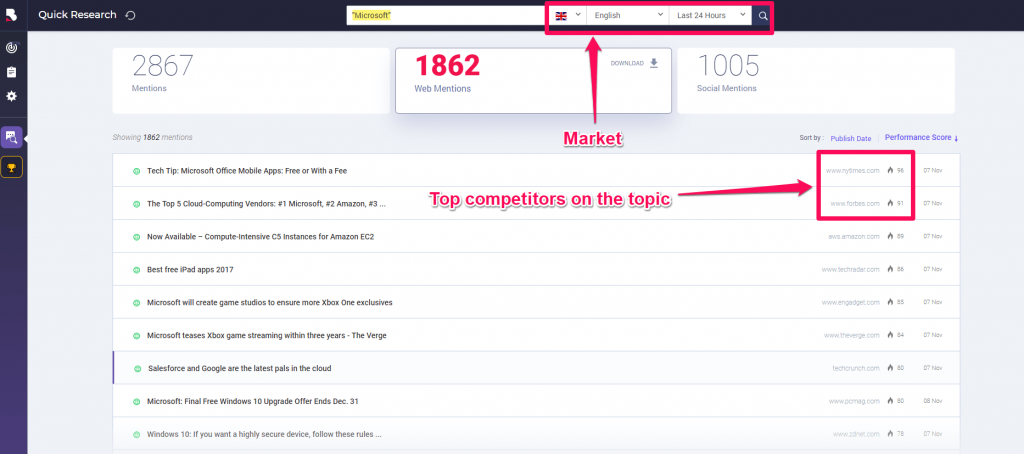
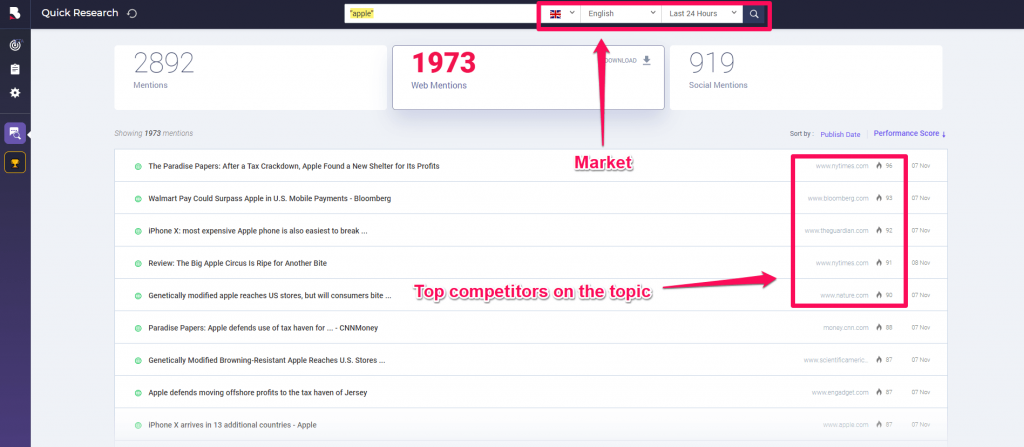
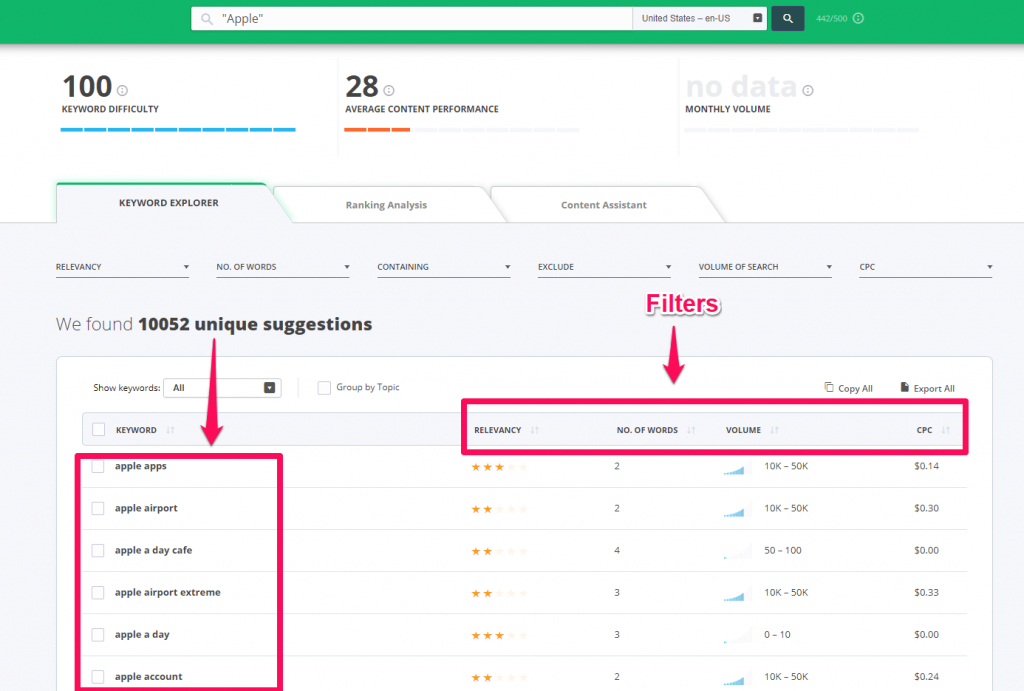
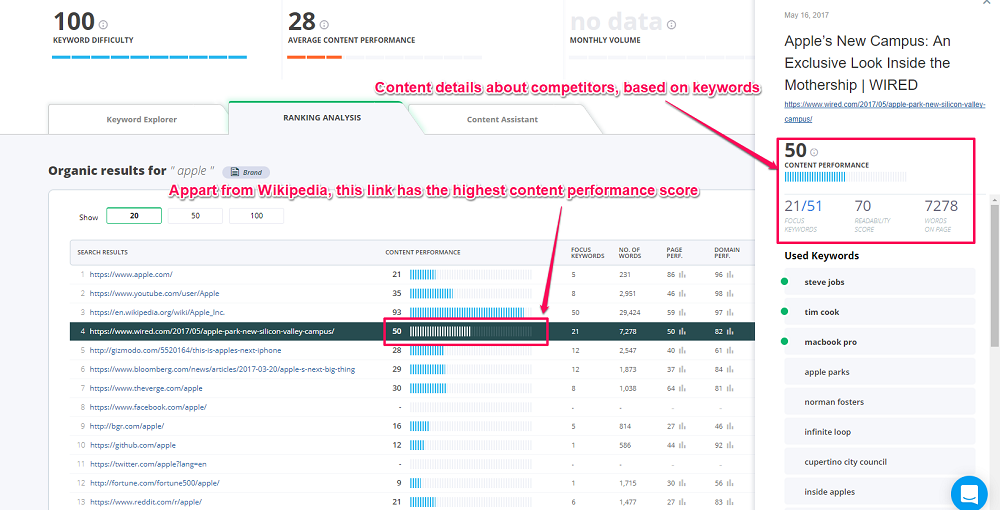
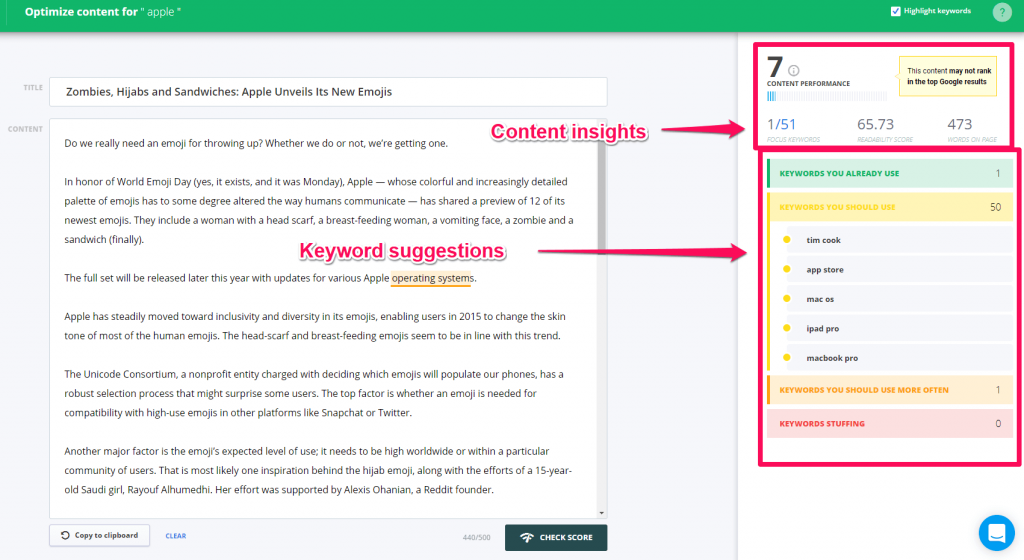
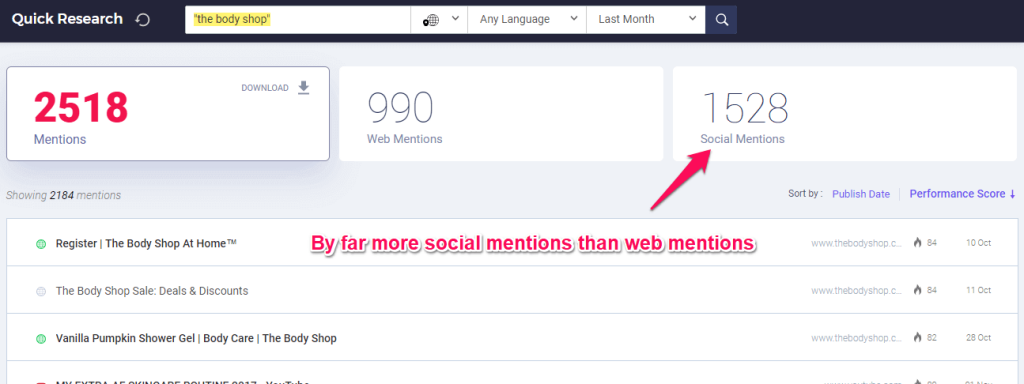
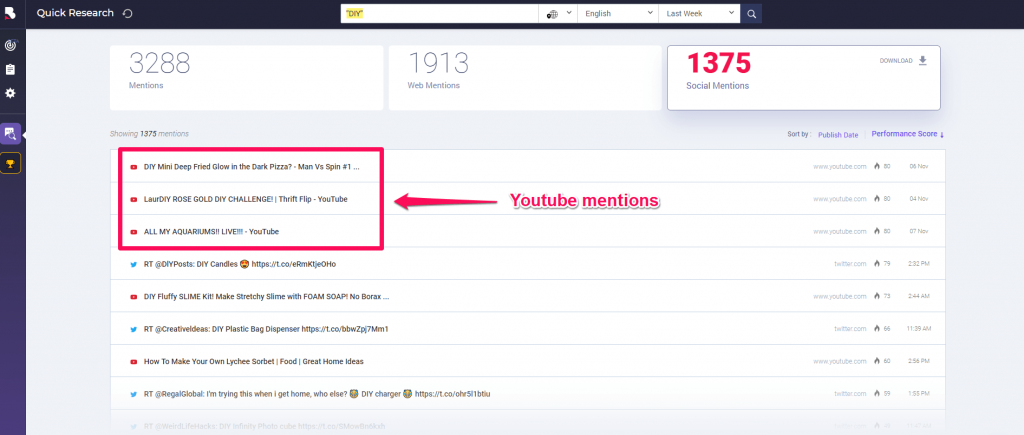



Really appreciate such detailed advice and how your tools fit into the process.
I am interested to know an additional aspect of the content optimization: when users of your content tool see the most success, have they typically optimized for only one goal search term, or do they utilize your content tool on the same content, optimizing it for several search terms? If several, what is a good maximum number of terms used (aka sessions of using the tool across the same content using distinct root keywords)?
Hi Steve,
I’m truly happy you found this article useful.
In regard to your questions, I can tell you that users usually optimize their texts for several search terms, not just for one.
Yet, this isn’t universally applicable as you can make your content rock either ways, whether you choose to optimize it for 1 word, or for 2-4 keywords which are strongly related to the main topic.
For more details on how to optimize your content, you can also check this: https://cognitiveseo.com/blog/15471/multiple-keywords-optimization/
Cheers!
Really Great information especially 4 the new learners who have no prior knowledge of these topics
Glad to hear that, Khurram! We all learn, regardless of our stage, be it beginner or advanced, so there’s always going to be something to discover and be amazed by.
Cheers!
Love your actionable tips! Very easy to read, understand and apply.